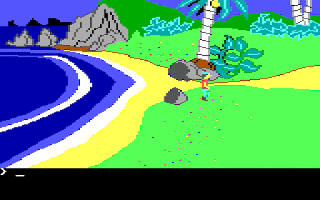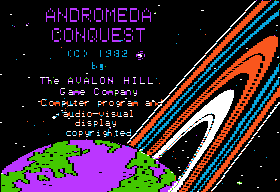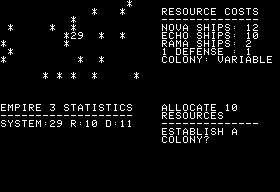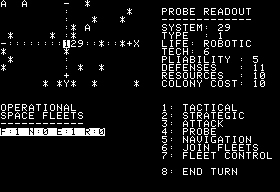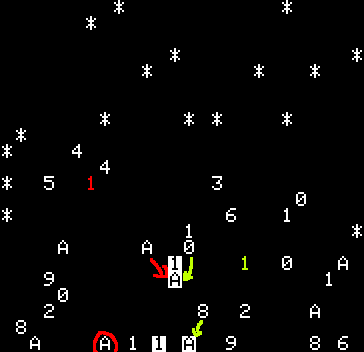 |
| Paralleling Personal Software's Zork, IBM took some liberties with the source material |
I never imagined I'd be thinking of King's Quest 1 as a next-gen title. Even when I first played its 1987 re-release and had no other graphic adventures to compare to, the game felt downright archaic. I remember hearing the ear-splitting beeper rendition of Greensleeves on startup, followed by some ugly and crude visuals of a castle exterior, and soon after the sinking realization that the game expected me to type phrases like "OPEN DOORS" and "TAKE KNIFE" in order to do things. Rediscovering the game in 1994 in a CD-ROM collection with its five sequels, didn't do its image any favors.
And today, I'm playing the even more archaic 1984 PCJr. version. Only now, it's in the context of a game that followed half a decade of adventure design hewing very closely to the progenitors of the genre, where graphics, if there even were any, served as a supplement to or a replacement for text descriptions. King's Quest is the first time that animated graphics are truly integral, and while the macro design is in many ways unsophisticated compared to Infocom's worlds and systems - King's Quest is, after all, a treasure hunt with some simple puzzles - there's a dynamism and living quality to its world that just wasn't possible before it. Things move when you interact with them. Things move even when you don't! For instance, you can be walking through the woods, watching your avatar pass through the trees, and suddenly hear a witch's hideous cackle as she swoops into your field of vision and makes you lunge for the 'duck' key before she can nab you. This is, oddly, something I appreciate much more now than I did decades ago when my only frame of reference was Nintendo where this sort of occurrence is nothing special.
The original PCJr. version comes with a uniquely-styled manual which hasn't since been reprinted.
 |
| Is this King's Quest or Fractured Fairy Tales? |
I've generally envisioned the series as somewhat serious and high fantasy-minded in tone, and the later versions' manual, complete with Andrew Lang-inspired prose and illustrations are more what I remember. The goofiness present in the series' earliest installments, I had assumed, was more or less unintentionally caused by a combination of crude technology, the animators' inexperience, and Williams not having quite found her footing yet. But the manual suggests fantasy pastiche was the intent all along. Either that or this is just how IBM's manual writer and illustrator interpreted it. In contrast to the fairy tale backstory seen in later manuals, here King Edward just wants you to find three magic treasures to bring prosperity back to the kingdom.
And with that, I started the game.
Apart from the interface observations I made in the last post, I also noticed that there's no status bar, and no drop-down menus as in the DOS version. Everything is done by typing, though a few special commands, like saving, loading, ducking, and swimming, have dedicated function keys. Your score, a permanent fixture of Sierra's AGI engine adventures, is consigned to a status screen here, and the maximum score isn't displayed.
I entered the castle and approached the throne room.
Daventry is laid out as a two-dimensional grid of "rooms," and most of them have four exits. Unlike, in, say, The Wizard and the Princess, where you start off lost in the desert and have to find the right rock so you can kill a snake and enter the next area, most of King's Quest's game world is open to you from the start. And yet, no doubt thanks to the increased disk space demands, King's Quest is (welcomingly) much more compactly designed than the Hi-Res Adventures, with fewer areas, but little wasted on filler, and there are no mazes to speak of here. Nearly every screen either has something to do or something interesting to look at. There's a pleasing logic to the world terrain too, without any obvious regional division, but having terrain that smoothly transitions from one screen to the next (we'll just let the north-south east-west toroid wrapping slide).
 |
| More woods to the north and east, more lake to the west. |
Heading west from the castle, I retrieved a dagger buried underneath a rock - a puzzle spoiled in this version by the screen drawing algorithm - and found a bag of diamonds inside a tree stump before arriving back again on the east side of the castle moat.
North of the castle lies a carrot patch, and to the west of that, a climbable tree.
 |
| Where have I seen a Faberge egg up in a tree before? |
King's Quest's treasure hunting does betray a somewhat dated design sensibility, rooted back in the Adventure tradition that other games had since evolved past, but even so, it does put its own spin on the trope. These treasures aren't the goal in themselves, but can be used as currency to bypass certain puzzles. Of course, to maximize your score, you'll want to find all of the treasures and solve all of the puzzles without giving them up.
West past the big tree, I dodged a wolf patrolling a meadow, and arrived at the game's first real challenge.
Back in the day, this part stumped me, mainly due to not understanding what the parser wanted of me. I remember getting frustrated trying "TURN HANDLE" in various spots around the well until I realized you just need to type "LOWER BUCKET" and then "RAISE BUCKET" to get a bucket of water. And then you deface public property by typing "CUT ROPE" to get the bucket of water.
But why stop there and settle for ruining the country's only water supply when you can contaminate it too? "LOWER ROPE" followed by "CLIMB ROPE" lets you do just that.
Drop in. It's fine. Then you can swim and use "DIVE" to go under.
A dragon! And if you can't tell, that's the magic mirror lying against a rock.
You can kill the dragon with your dagger, or throw water in its face. The latter is worth more points, but either way, the mirror is yours, and by looking into it, you may see a glimpse of your future as king.
Leaving as you came is worth more points than leaving by the boulder entrance.
Further west is a goat that you can lure with a carrot from the patch.
Having a big, smelly goat by your side is pretty handy, as the various nasties lurking in the dangerous corners of Daventry will leave you alone, but you've got to be careful not to fall in any water or he'll abandon you. You can't go indoors anywhere either. It's also easier to get stuck on the terrain, as your collision box is now twice as big.
 |
| Sir Grahame has no need for your paltry majicks. I have a goat! |
 |
| Who's the apex predator now? |
 |
| But this can be annoying. |
 |
| He will be important later. |
In the horizontal slice of Daventry north of the goat, I found a four-leaf clover, an elf offering a magic ring, a tree bearing golden walnuts, and a magic bowl of unlimited stew before arriving at the goat's purpose.
 |
| It's violence or it's bribery. For once, violence is better. |
But we don't want to cross the bridge just yet. We have more murder to do! A few screens to the east is a familiar sight.
Eat the house to find out if the witch is home. If so, leave and try again. If not, enter.
 |
| And immediately hide in the bedroom. |
You know the drill. Push her in, then raid her house. Her possessions are a piece of Swiss cheese and a note that cryptically reads "sometimes it is wise to think backwards."
Back to the bridge, and the other side.
Welcome to the worst puzzle of the game, possibly of the entire series! This gnome wants you to guess his name and offers three guesses.
Guess Rumplestiltskin, and you're wrong.
Guess that the witch's note is the key, and, well, congratulations, because I have no idea how anyone would figure that out on their own, but if you guess "Nikstlitselpmur," you're still wrong, but he'll be generous enough to let you know you're on the right track.
The correct answer here is "Ifnkovhgroghprm," found by performing a reversed-alphabet substitution cipher.
To be fair, you don't have to get his name right to win the game. In fact, your reward is almost a punishment - magic beans which unlock a ridiculously perilous trip to the clouds when a much safer path can be unlocked by failing. But to maximize your score you must not only guess his name, but guess right on the first try. Sheesh.
There's just a bit more earth-based business before we take to the sky. Pebbles can be collected on the west river bank, and a woodcutter, found east of the river, offers his fiddle in exchange for the bowl of stew.
 |
| Be careful not to fall through the cracks. |
 |
| This sorcerer isn't the same one found in the DOS version. |
Finally, we plant the beans in a field and climb.
 |
| Things are looking... up? |
 |
| Top of the world, ma! |
I remember the beanstalk being extremely deadly, misstepping and falling from it to my death again and again, and then in the 1990 remake it was even worse. But this time I made it to the top in one try. Did I just get lucky, or did the DOS version make climbing it harder than intended?
In any event, cloud land is the home of the infinite treasure chest, and the second worst puzzle in the game.
There's a practical solution that's simple enough. A sling, hidden in a tree hollow nearby, lets you kill the giant with your pebbles. But to maximize your score, you've got to wait for him to fall asleep, which takes a few minutes of real time. The magic ring will turn you invisible just long enough for this to happen.
Regardless of the solution used, the chest of infinity gold is yours, and so is hyperinflation if you don't use it responsibly.
A cavernous staircase provides a safer path to the ground.
Two down, one to go. I went back to the condor's area, ready to take on King's Quest's last adventure.
Don't jump down that hole yet - there's something super important one screen to the left - a magic mushroom found on the east bank of a previously impassable river!
I went down the hole.
Further down the cave, a gigantic rat impeded my progress, but could be passed by offering the witch's cheese. Alternately, a treasure will do.
By possessing the four-leaf clover, the leprechauns won't harm you, and you can simply take their magic shield. By playing the fiddle, you can entertain them and also steal the king's golden sceptre as they dance.
The stairs west lead to a dead-end, but the magic mushroom, which you hopefully didn't already eat, shrinks you down small enough to leave.
Back at the castle, King Edward, overcome with emotion, has a coronary and dies.
And that's the end. I finished with 153 points, which is less than the maximum score of 158 in the DOS version. On a replay, I figured out how to get 158 (or more through an exploit).
- Tire out the giant without using the ring to get an extra 3 points. This is easy if you have the magic shield.
- Give the woodcutter the empty bowl and then fill it for an extra two points and the satisfaction of giving him unlimited meals instead of just one. In the DOS-AGI version, you score two points no matter when you fill it, though you'll score none if you read the word at the bottom first, which is probably a bug. In the DOS-SCI version, you score one point for reading the word at the bottom and another two for filling the bowl, but teaching the woodcutter how to refill the bowl isn't possible.
- If you save and restore while on the rope inside the well interior, you will score a point. This is infinitely repeatable. This does not work in the DOS-AGI version.
 |
| No maximum is stated in this version. |
Points list for a presumed optimal 158 point game:
| Action | Points | Total |
| Enter castle | 1 | 1 |
| Bow | 3 | 4 |
| Move rock | 2 | 6 |
| Get dagger | 5 | 11 |
| Look in stump | 1 | 12 |
| Get pouch | 3 | 15 |
| Look in pouch | 3 | 18 |
| Get carrot | 2 | 20 |
| Climb tree | 2 | 22 |
| Get egg | 6 | 28 |
| Cut rope | 2 | 30 |
| Enter well (repeatable through save/restore exploit) | 1 | 31 |
| Swim / get water | 2 | 33 |
| Dive | 2 | 35 |
| Enter cave | 1 | 36 |
| Throw water at dragon | 5 | 41 |
| Get mirror | 8 | 49 |
| Get water (second time) | 2 | 51 |
| Show carrot | 5 | 56 |
| Get clover | 2 | 58 |
| Get ring | 3 | 61 |
| Get walnut | 3 | 64 |
| Open walnut | 3 | 67 |
| Get bowl | 3 | 70 |
| Read word | 1 | 71 |
| Kill troll | 4 | 75 |
| Eat house | 2 | 77 |
| Push witch | 7 | 84 |
| Get note | 2 | 86 |
| Read note | 1 | 87 |
| Open cupboard | 2 | 89 |
| Get cheese | 2 | 91 |
| Guess name | 5 | 96 |
| Get beans | 4 | 100 |
| Plant beans | 2 | 102 |
| Get pebbles | 1 | 103 |
| Give bowl | 3 | 106 |
| Fill | 2 | 108 |
| Get fiddle | 3 | 111 |
| Fly with condor | 3 | 114 |
| Get mushroom | 1 | 115 |
| Give cheese | 2 | 117 |
| Play fiddle | 3 | 120 |
| Get shield | 8 | 128 |
| Get sceptre | 6 | 134 |
| Eat mushroom | 2 | 136 |
| Exit hole | 1 | 137 |
| Wait for giant to sleep (don't use the magic ring) | 7 | 144 |
| Get chest | 8 | 152 |
| Get slingshot | 2 | 154 |
| Enter castle | 1 | 155 |
| Bow | 3 | 158 |
GAB rating: Good. The King's Quest series has been criticized, and rightly to some extent, for shallowness, inept design, confounding puzzles, and unfair deaths. We can certainly see that germinating here, but this first game is saved by its own open-endedness and flexible, multi-solution puzzles. It's a design that is gradually phased out as the series progresses, shedding its treasure hunt roots in favor of increasingly more linear, and more story-driven structure, and in those later games, Williams' obtuseness often brings the experience to a screeching, frustrating halt. But here, those aspects of the series aren't fully developed, and the end result is a game that's not just a technical revolution, but a pleasant, enjoyable experience, where some of the retrospective oddness is part of the charm.
Now that I've finally played the PCJr. version, I think I can say that this was a more definitive experience than the more common DOS one. Some of the game's design aspects, like its terse room descriptions, suddenly make sense in the context of this early engine version where output is shown in the lower area of the screen. And while I once thought, back when I played King's Quest II for the first time, that the sequel had lazily copied its music, sound effects, and certain enemy sprites from the original game, I now realize that it was in fact the DOS re-release of the original that retroactively copied from KQ2, and in doing so, lost its music, sound effects, and even some animations. You're supposed to hear birds and crickets chirping as you lose yourself in Daventry, hear the goat bleating, the troll's footsteps stamping on the bridge, and see King Edward's tragicomic staggering dance of death. These little things are subtle, but lost in the upgraded DOS version which has long taken its place as the de facto version.
That said, this is likely the last Sierra adventure game I'm going to
play for a very long time. The only reason I even replayed this was out
of the realization that I was unfamiliar with the original PCJr.
version, and King's Quest 2's original booter version just isn't different enough to be worth covering. I've pretty much played the majority of Sierra's adventures to death long before starting this blog - the earliest whale that I have yet to play is Phantasmagoria. It's possible that I might replay a title or two per year at the very most, just for old time's sake, but don't count on it. King's Quest may have once been the beginning of an era, but for my intents and purposes in 2022, it's the end of one.































